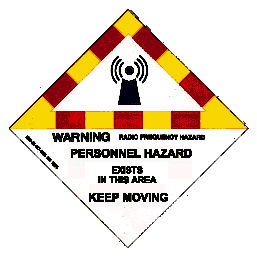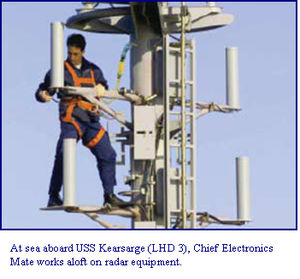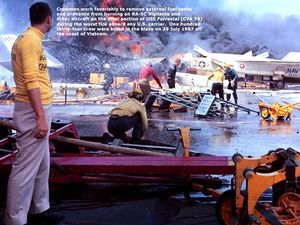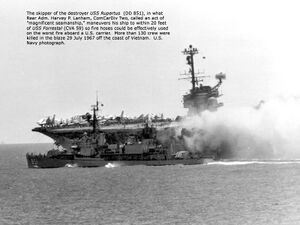Safety and survivability of naval vessels: Difference between revisions
imported>Howard C. Berkowitz |
imported>Howard C. Berkowitz |
||
| Line 17: | Line 17: | ||
[[Image:Navy-RF-Warning.jpg|thumb|left|Intense electromagnetic radiation is a constant concern]] | [[Image:Navy-RF-Warning.jpg|thumb|left|Intense electromagnetic radiation is a constant concern]] | ||
===Hazards of Electromagnetic Radiation to Personnel (HERP)=== | ===Hazards of Electromagnetic Radiation to Personnel (HERP)=== | ||
Radar and | [[Radar]] and [[radio]] trasmitters present a biological hazard to personnel working on, or in the vicinity of, these systems. It is not a coincidence that the everyday microwave oven derives from military radar technology. | ||
Burns can be produced not only by radiation, but by having a body part form a conductive path; this is equally a danger from direct current power supplies as from radio and radar frequencies. | |||
[[Image:ShipSafety-HERP-Aloft.jpg|thumb|Antenna work presents both RF and fall hazards]] | [[Image:ShipSafety-HERP-Aloft.jpg|thumb|Antenna work presents both RF and fall hazards]] | ||
In the presence of strong radio signals, especially in the [[ITU frequency bands|very high frequency (VHF)]] and lower frequency range, metal cables, or any metal object long enough to act as an antenna, can be a shock or burn hazard. | |||
Other than in desperate emergency conditions, the power to all antennas, where a crew member is to go aloft, should be physically disconnected. The sailor going aloft may put a safety lockout through the power switch and keep the key. Even receiving antennas can be dangerous if they can rotate, and hit a sailor with considerable force. | |||
===Hazard of Electromagnetic Radiation to Ordnance (HERO)=== | ===Hazard of Electromagnetic Radiation to Ordnance (HERO)=== | ||
The high intensity RFR fields produced by modern radio and radar transmitting equipment can cause sensitive electrically initiated devices (EIDs), classically known as electro-explosive devices (EEDs), contained in ordnance systems to actuate prematurely. RFR energy may enter an ordnance item through a hole or crack in its skin or through firing leads, wires, and so on. In general, electrically initiated ordnance systems are most susceptible during assembly, disassembly, loading, unloading, and handling in RFR electromagnetic fields. The potential dangers to ordnance and fuels are obvious because there could be an explosive chain reaction. | The high intensity RFR fields produced by modern radio and radar transmitting equipment can cause sensitive electrically initiated devices (EIDs), classically known as electro-explosive devices (EEDs), contained in ordnance systems to actuate prematurely. RFR energy may enter an ordnance item through a hole or crack in its skin or through firing leads, wires, and so on. In general, electrically initiated ordnance systems are most susceptible during assembly, disassembly, loading, unloading, and handling in RFR electromagnetic fields. The potential dangers to ordnance and fuels are obvious because there could be an explosive chain reaction. | ||
| Line 37: | Line 37: | ||
| publisher = U.S. National Aeronautics and Space Administration}}</ref> The rocket and its launching triple ejector rack each had a separate electrical connector that enabled the rocket to be launched. The two arming connectors were to be inserted, under standard operating procedures, only when the aircraft was on the [[catapult]], weapons aimed in a safe direction. To improve speed, the ship's Weapons Coordination Board approved the early insertion of one of the pins. Unfortunately, the WCB board never forwarded its recommendation to higher authority, and, without consultation, flight deck crews had also decided to find a faster way to launch, by pre-inserting a connector. | | publisher = U.S. National Aeronautics and Space Administration}}</ref> The rocket and its launching triple ejector rack each had a separate electrical connector that enabled the rocket to be launched. The two arming connectors were to be inserted, under standard operating procedures, only when the aircraft was on the [[catapult]], weapons aimed in a safe direction. To improve speed, the ship's Weapons Coordination Board approved the early insertion of one of the pins. Unfortunately, the WCB board never forwarded its recommendation to higher authority, and, without consultation, flight deck crews had also decided to find a faster way to launch, by pre-inserting a connector. | ||
Unfortunately, that connector was the second of the two. Each group assumed that the other pin was not yet installed, so the fighter was moved along the deck with both arming pins in place. When the rocket fired, it shot across the deck and hit an [[A-4 Skyhawk]] attack aircraft piloted by [[John McCain]], tearing open its fuel tank and starting a major fire, which, in turn, set off bombs. | Unfortunately, that connector was the second of the two. Each group assumed that the other pin was not yet installed, so the fighter was moved along the deck with both arming pins in place. When the rocket fired, it shot across the deck and hit an [[A-4 Skyhawk]] attack aircraft piloted by [[John McCain]], tearing open its fuel tank and starting a major fire, which, in turn, set off bombs. | ||
==Explosive ordnance safety== | ==Explosive ordnance safety== | ||
The ''Forrestal'' fire, as well as the earlier ''Oriskany'' fire were especially catastrophic because the best-trained firefighters were killed or disabled in the first blast. One of the traditions of the [[U.S. Marine Corps]] is that every Marine, of every rank and skill, is always qualified as a rifleman. The [[U.S. Navy]] had already had a strong tradition of training in damage control, but these incidents led to a tradition that every sailor is always qualified as a firefighter. | The ''Forrestal'' fire, as well as the earlier ''Oriskany'' fire were especially catastrophic because the best-trained firefighters were killed or disabled in the first blast. One of the traditions of the [[U.S. Marine Corps]] is that every Marine, of every rank and skill, is always qualified as a rifleman. The [[U.S. Navy]] had already had a strong tradition of training in damage control, but these incidents led to a tradition that every sailor is always qualified as a firefighter. | ||
Revision as of 22:40, 30 September 2008
Template:TOC-right Most modern warships have high-power radar and radio equipment that require significant safety precautions. [1]Aircraft carriers and warships operating helicopters also offer the danger of being run over by aircraft, sucked into jet engines, cut in half by a snapped arresting wire.
These hazards are present in peacetime, when the sea is both friend and foe. In active warfare, natural and "friendly" threats are joined by other people using their best ability to do more damage than the sea.
No man will be a sailor who has contrivance enough to get himself into a jail; for being in a ship is being in a jail, with the chance of being drowned... a man in a jail has more room, better food, and commonly better company — Samuel Johnson
Beyond the measures prescribed for civilian vessels by the Safety of Life at Sea convention, warships need specialized protective systems as well as procedures for safe handling of things designed to blow up and break things.
Compartmentation
In general, warships are most concerned about being struck by a torpedo or mine, which explode below the waterline, than from shells or bombs. Underwater explosions let water in, while hits above the waterline will provide a path for air — unless they spread fire, or penetrate deeply enough to create holes below the waterline.
Flooding and fire protection
Chemical, biological and radiological protection
Electromagnetic Hazards
Hazards of Electromagnetic Radiation to Personnel (HERP)
Radar and radio trasmitters present a biological hazard to personnel working on, or in the vicinity of, these systems. It is not a coincidence that the everyday microwave oven derives from military radar technology.
Burns can be produced not only by radiation, but by having a body part form a conductive path; this is equally a danger from direct current power supplies as from radio and radar frequencies.
In the presence of strong radio signals, especially in the very high frequency (VHF) and lower frequency range, metal cables, or any metal object long enough to act as an antenna, can be a shock or burn hazard.
Other than in desperate emergency conditions, the power to all antennas, where a crew member is to go aloft, should be physically disconnected. The sailor going aloft may put a safety lockout through the power switch and keep the key. Even receiving antennas can be dangerous if they can rotate, and hit a sailor with considerable force.
Hazard of Electromagnetic Radiation to Ordnance (HERO)
The high intensity RFR fields produced by modern radio and radar transmitting equipment can cause sensitive electrically initiated devices (EIDs), classically known as electro-explosive devices (EEDs), contained in ordnance systems to actuate prematurely. RFR energy may enter an ordnance item through a hole or crack in its skin or through firing leads, wires, and so on. In general, electrically initiated ordnance systems are most susceptible during assembly, disassembly, loading, unloading, and handling in RFR electromagnetic fields. The potential dangers to ordnance and fuels are obvious because there could be an explosive chain reaction.
Other electrical problems can affect ordnance. In the image, fire, 134 men were killed and 161 injured, started when an Zuni air-to-ground 5" rocket, aboard an F-4 Phantom II fighter, piloted by Jim Bangert fired, when it was switched from external to internal electrical power. [2] The rocket and its launching triple ejector rack each had a separate electrical connector that enabled the rocket to be launched. The two arming connectors were to be inserted, under standard operating procedures, only when the aircraft was on the catapult, weapons aimed in a safe direction. To improve speed, the ship's Weapons Coordination Board approved the early insertion of one of the pins. Unfortunately, the WCB board never forwarded its recommendation to higher authority, and, without consultation, flight deck crews had also decided to find a faster way to launch, by pre-inserting a connector.
Unfortunately, that connector was the second of the two. Each group assumed that the other pin was not yet installed, so the fighter was moved along the deck with both arming pins in place. When the rocket fired, it shot across the deck and hit an A-4 Skyhawk attack aircraft piloted by John McCain, tearing open its fuel tank and starting a major fire, which, in turn, set off bombs.
Explosive ordnance safety
The Forrestal fire, as well as the earlier Oriskany fire were especially catastrophic because the best-trained firefighters were killed or disabled in the first blast. One of the traditions of the U.S. Marine Corps is that every Marine, of every rank and skill, is always qualified as a rifleman. The U.S. Navy had already had a strong tradition of training in damage control, but these incidents led to a tradition that every sailor is always qualified as a firefighter.
Since carrier aircraft and naval ordnance are in much closer proximity than at a land base, bombs, missiles, and other ordnance approved for carrier use often has a coating of thermal insulation, to buy more time for firefighters and explosive ordnance disposal personnel to get to the endangered weapon. These explosives also are likelier to be in strong electromagnetic fields than on shore. When Army helicopters began to operate from Naval vessels, they often had to jettison their weapons into the sea before landing, since the Army weapons had neither the thermal nor the electromagnetic protection required for carrier safety.
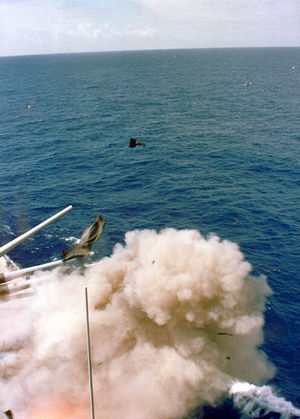
During a firing exercise, there was a catastrophic explosion in a 16" gun turret aboard the battleship USS Iowa'. The cause has never been definitively established, but the most generally accepted technical explanation is that bags of loose propellant (i.e., smokeless gunpowder) were rammed too quickly into the breech of the gun. [3] Many turret explosions have been attributed to naval guns of this type, which are no longer used. While extensive safety measures were used to prevent accidental sparks near propellant, or even more catastrophic turret explosions that extended into the stored ammunition in the magazine below, safety measures were often overridden in the interest of speed in battle. The motivation is understandable, as not firing fast enough to stop enemy fire can be as lethal as mistakes with one's own weapons.
Aircraft operations safety
It is clearly unhealthy to be in the path of a moving aircraft or a helicopter rotor. These are only a few of the hazards especially on the deck of an aircraft carrier, but also in the flight operations areas of destroyers and cruisers.
Jet engines are far noisier than the loudest hard rock band; it is not a question if one's hearing will be damaged by unprotected exposure, but how quickly permanent damage happen. [4]
The arresting wire system of an aircraft carrier using the Catapult Assisted Take Off But Arrested Recovery (CATOBAR) technique takes extreme stress in decelerating a multi-ton aircraft, moving at 150mph/240 kph, to stop in seconds. In spite of careful inspection, in spite of calculated braking systems on the wires, they sometimes snap. A breaking arresting wire has immense kinetic energy and moves in unpredictable ways. In a 2005 accident with a wire break, there were three major and three minor casualties among the 26 personnel on the deck and two in the aircraft, which created a mass casualty incident even aboard a ship that could expect hundreds of casualties.[5] As well as being a firefighter, every sailor must be a medical first responder; it was a air department chief petty officer that applied an appropriate tourniquet to the worst-injured sailor, who had a below-the-knee leg amputation.
References
- ↑ Naval Safety Center, Acquisition Safety - Radio Frequency Radiation (RFR) Hazards
- ↑ O’ Connor, Bryan & Jim Lloyd (January 2008), Forrestal in Flames: Explosions Aboard USS Forrestal, U.S. National Aeronautics and Space Administration
- ↑ Charles, Dan, "[14 September 1991 Battleship blast was accident, not suicide]", New Scientist
- ↑ Rovig GW, Bohnker BK, Page, JC (June 2004), "Hearing Health Risk in a Population of Aircraft Carrier Flight Deck Personnel", Military Medicine
- ↑ Chavez T, Cubano N, Hovijitra Ry (July 2005), "Mass Casualty aboard USS Kitty Hawk (CV 63) January 2005-Lessons Learned", Military Medicine
